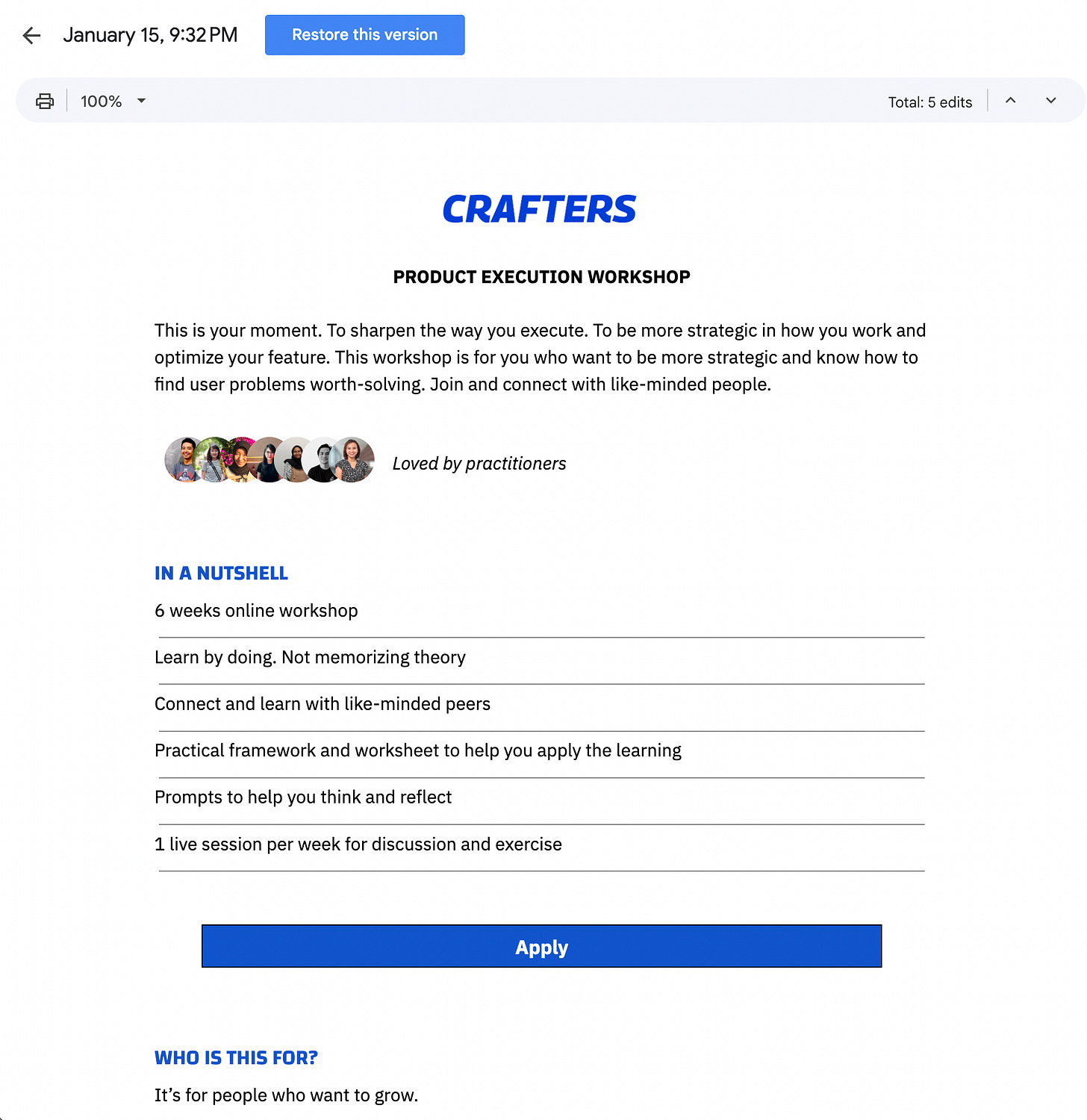My journey building Crafters so far...
A reflection of my journey building an online learning program
For you who want to get a glimpse of my progress in building my business or product
Hi friends, it’s been a while!
I am happy to announce that I’ll actively write the newsletter again.
Early this year, I decided to build Crafters.
It’s a learning program for practitioners to level up products and design skills.
Today, I want to share my learnings from the past three months of building my product and business. I hope this learning can spark the discussion or become a learning for you too.
Why build Crafters?
The reason I do this? Simply put, I struggled a lot throughout my career. As I progressed toward my career, I worked on more complex problems. That’s hard, and I can’t get practical resources to help me navigate that.
In 12 years of my career, I discovered and created a lot of frameworks to help me navigate the challenge and solve problems. Whenever I find a practical framework, it’s like a magic moment, “I wished I knew this way of thinking sooner.” So I want to share this knowledge.
Besides, I always have the inner desire to build my own thing.
Complication
I want the learning experience to be practical. Something that people can apply back to their work right away. But I was nervous:
Do people want this?
Do they want to pay for this?
Can I produce a good lesson?
What platform should I use?
and so on…
Validate the risks
Thanks to my experience in PM-ing a product, I knew it’s always a good idea to start with validating small risks.
1 - Do people want this?
First, I feel that validating the demand is important. So I reached out to my audience on Instagram. I said to them that I was building this program to learn about product thinking. To my surprise, 56 people joined the waiting list.
2 - Do people want to pay for this?
Okay, 56 people are interested. But do they want to pay? I want to give my best to produce the lesson. So, I know I need a sustainable business model in the long run.
So, I designed the very basic curriculum for people on my waitlist. I wrote a Google Doc instead of creating a landing page. I got ten people paid. Being scrappy is super important if you want to learn quickly.
3 - Can I design a practical learning experience?
Now that I validated my biggest fear about demand. It’s showtime. How can I create practical learning that is delightful and insightful?
After grinding for about a month, I finally tested the program with the first 10 alpha learners. I’m glad I did this because I can improve quickly with instant feedback from the learners.
Suddenly, I recorded a voice-over, edited a video, created visuals, and so on. It’s tough mentally and physically. But I kept going,
After running 2 cohorts with 40 learners in the past 4 months, I learned a lot.
Learnings
01 — Learn what’s effective. I was constantly anxious during the alpha and beta tests because some parts felt good, but some felt broken. Creating a lesson video and voice-over is the most embarrassing part of this MVP process. My intonation was off and all that. But 100% of learners give a high rating of effectiveness. So this increases my confidence and focuses my attention on what’s ineffective.
02 — The satisfaction was okay. I got a lot of 8 out of 10 satisfaction scores. This is super interesting. It indicates that most learners are somewhat satisfied but not super satisfied. Then I dig into why.
03 — The length was the detractor factor. Just for context, the program was very intense. It was 6 weeks, in which all students spent 1-2 hours daily. I observed the energy was constantly dropping after week 3. It’s understandable. It’s hard to keep up that energy if you’re working as a full-time professional.
04 — Shaping the product while. Separate good-fit customers from bad-fit customers. You want to continue refining the target audience and delight that group. Look for their satisfaction score. Narrow down the characteristic of the people who are truly satisfied with your product.
05 — Chunking the risks. If you want to build a product, it’s important to chunk the risks and validates them. Don’t wait months. Do it quickly because you have limited resources.
06 — Figure out key values to help you position your product. I was struggling to position my program at first. By asking for feedback and talking to customers, you’ll gain more understanding what’s the key value of the product. This helps you understand the differentiation point and how to position your product compared to the alternative.
07 — Sometimes, your mind plays tricks. This clip always helps me cheer up:
Way forward
There are 20 people lined up to join Cohort 3.
As much as I’d love to start the next cohort, I don’t want to compromise the learning experience. So I messaged all of them and said I would improve the program. The next cohort will be delayed. I’m glad they’re all very supportive.
Next, I’m focusing on creating a program that people can join within 2 weeks and use the learning immediately back to work.
Thank you to all alpha and beta members. If you’re reading this, you know you’re a very special part of this journey.
P.S.
I hope you enjoy this newsletter after a while. As always, thanks for all the support! When the Crafters is available for the public, I’ll share it through this newsletter.
Upcoming newsletter:
Dear Budi: How to build my development plan if my manager is passive?
Dear Budi: What’s the roadmap to learning product design?




As a person who is currently building my own digital product, I can relate to every points from your words. Also, thanks for the clip!